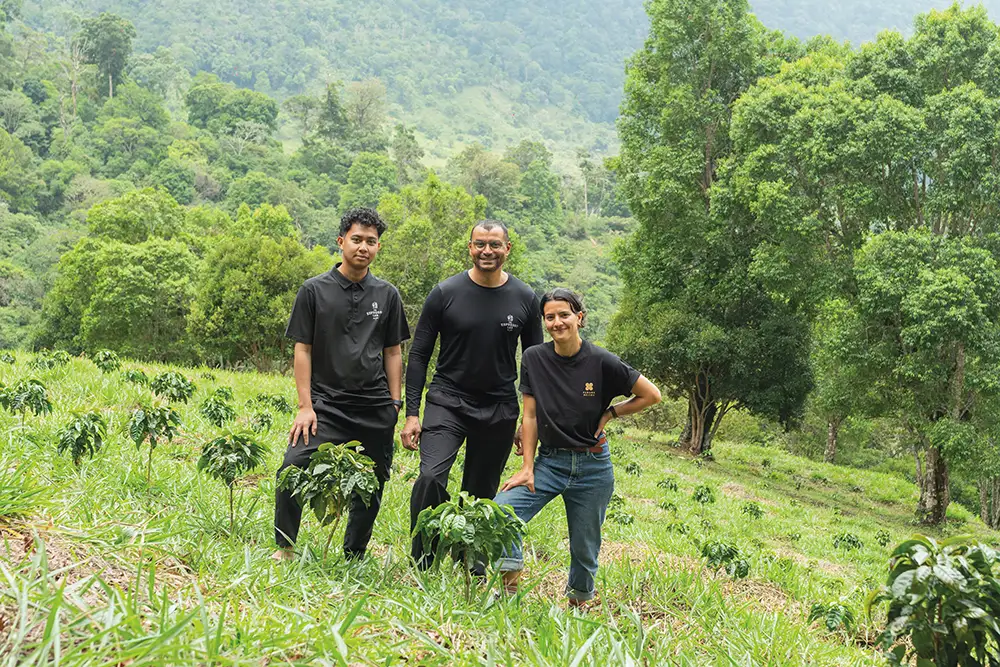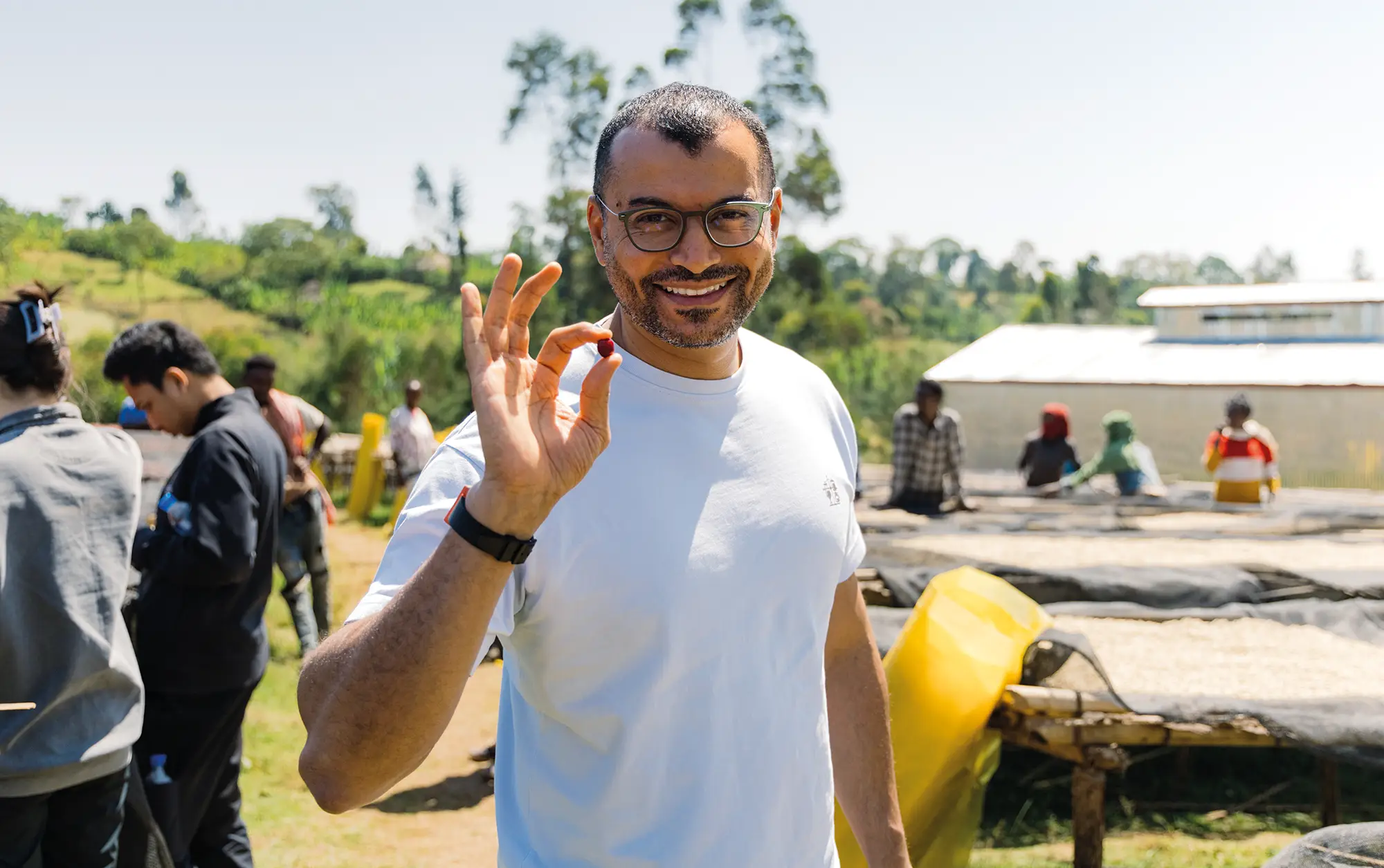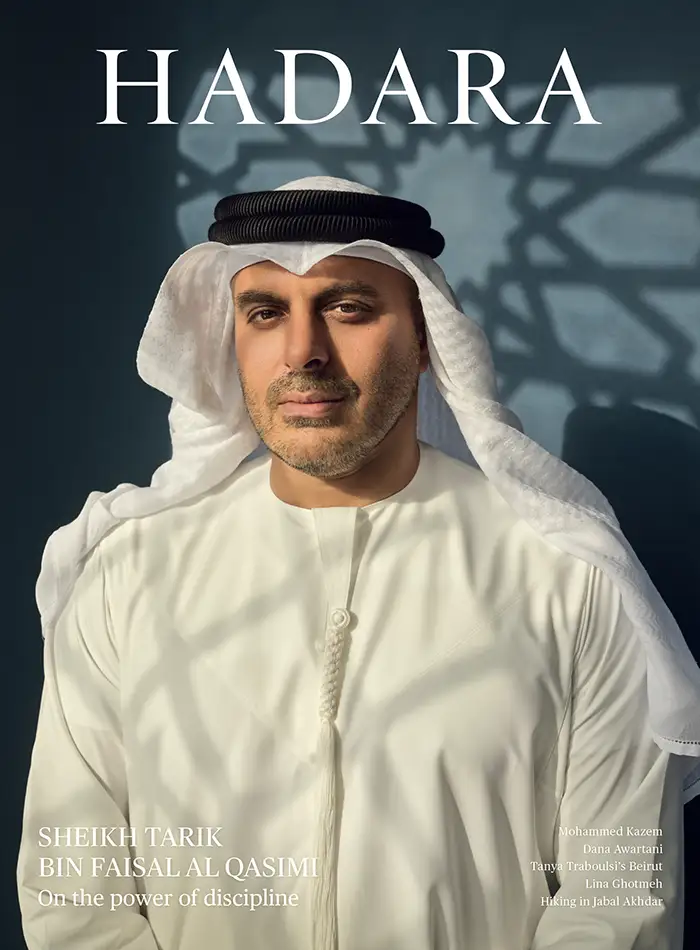The connoisseur
Ibrahim Al Mallouhi is serious about coffee, from crop to cup.
By Catherine Mazy
When Ibrahim Al Mallouhi was a boy, he would watch his grandmother roast coffee beans. She would fan the hot coals and toss the beans in a cast-iron skillet until they were uniformly the right shade of brown. She would grind them and make coffee, its perfume even silkier than that of the roasting beans.
The rituals of coffee that Al Mallouhi’s grandmother performed date back centuries in the Arab world. “Coffee has been in our culture since day one,” Al Mallouhi says, noting that the Emirati one dirham coin features a dallah, the iconic Arab coffee pot.
Today, Al Mallouhi is the one doing the roasting, grinding and brewing. Sometimes literally but more often figuratively as the head of The Espresso Lab, whose first location he opened in 2015. It now has four locations in the UAE, with two more in the pipeline. “I knew coffee would be part of my future,” he says. “I have a passion for coffee.”
With The Espresso Lab, Al Mallouhi aims to elevate and personalise coffee culture, entrenching a movement towards specialty coffee that is ethically sourced and responsibly cultivated. He seeks too to anchor the experience in regional tradition—coffee served in the majlis. “We started to do the same thing but in a modern way,” he says.
Al Mallouhi visits each farm that supplies The Espresso Lab with coffee. He considers not only the taste of the coffee in the cup but also the care of the plants, the qualities of the soil (much like the concept of terroir), the altitude of the farm and the farm’s sustainability practices. “It has to align with our vision and mission,” he says. He builds relationships with the farmers he sources from, telling their stories as he debuts their coffee.
How the seed, or pit, of the cherry of a small tree came to be roasted, ground and brewed into the world’s most popular beverage after water is a legend as murky as a cup of coffee itself. Most experts think that the plant originated in Ethiopia, perhaps in the province of Kaffa in the country’s southwest. A Kaffa goatherd in the late ninth century often gets credit as the first person to eat a coffee cherry. He noticed that his animals didn’t sleep after eating the fruit and decided to give it a try. Eventually, the plant made its way across the Red Sea to Yemen. Ethiopia and Yemen both claim credit for roasting and brewing the beans, which seems to have developed around the 13th century. Experimentation with new beverages was necessary—until relatively recently, drinking water was rarely pure, so people have long masked the taste by adding flavourings.

Al Mallouhi bought Finca Rasha, a coffee farm in Panama’s Cordillera de Talamanca mountains, as part of his mission to engage the coffee supply chain and his dedication to traceability. Photo byJuan Romero courtesy of The Espresso Lab.
Though growing in popularity, more coffee was drunk than documented until the Ottoman Empire introduced it to its new territories. Not only did coffee gain new devotees in Europe but they spread its cultivation, first to Java in the 17th century and then to the Americas in the 18th century. And near the end of the 18th century, the American Revolution might have been sparked by tea taxes, but coffee came out the big winner. From the Arab world to Europe, coffeehouses became places to discuss intellectual ideas. While new brewing methods have been developed, the communal aspect of coffee continues to this day, Al Mallouhi says.
One thing that has changed drastically is the care that goes into producing the very best beans. Coffee plants separate broadly into two families: robusta and arabica. Robusta tends to go into mass-market and instant coffees. Arabica has been further refined into different varietals that offer different notes, like floral or fruity. One of the most prized, but among the hardest to grow, is Geisha, which comes not from Japan but from the Gori Gesha forest in Ethiopia. Al Mallouhi has planted more than 7,000 Geisha coffee trees at Finca Rasha, a coffee farm he bought in Panama’s Cordillera de Talamanca mountains as part of his mission to engage the entire coffee supply chain, and dedication to traceability.
“Yes, Geisha is very hard to grow,” he says. “You have to treat the tree like a baby, but it produces notes that are very floral, with peach, nectarine, jasmine. This is what makes it unique.”
Coffee is a strange plant that likes tropical latitudes but high, cool, damp altitudes. Finca Rasha is 1,700 to 2,000 meters above sea level. Al Mallouhi is interplanting his coffee with other trees to provide shade, choosing shade trees that won’t take away what the coffee trees need from the soil. Coffee trees live 20 to 30 years, but the first years aren’t productive (Finca Rasha’s first harvest is expected in May 2029), so planning and attention to detail are essential. “We cannot control climate change,” he says. “We cannot control natural disasters. Our responsibility is to take care of the plants and the land with current knowledge and the best resources we have.”
Even when Finca Rasha can supply The Espresso Lab with a complete harvest, the company’s ethos is about serving the best coffee to everyone, and taste is personal. That means Al Mallouhi scours the global coffee belt in search of the best beans. He usually makes three trips a year, stopping at several countries each time. Ethiopia, Kenya, Colombia, Panama, Brazil, Indonesia, Yemen, Ecuador, Costa Rica, Guatemala, Honduras, Bolivia…“I keep searching,” he says.
He recently added two Geisha lots to the menu at The Espresso Lab, both from the Los Rodríguez estate in the La Paz Caranavi region of Bolivia, a family farm dedicated to quality, rare varietals, and innovative processing. Las Alasitas has notes of orange blossom, mandarin and nectarine, while Salvaje Alasitas brings mango, berries, and delicate lily blossom. Both, he says, showcase the vibrant character of high-quality Bolivian specialty coffee.
Roasting and brewing are other opportunities to affect flavour. While Al Mallouhi likes a light roast, “I cannot say that dark roast is wrong. Some people like that taste.” He finds a pourover the best bet for brewing. The through line in these personal preferences is the primacy of quality. “You can taste the difference,” he says.

Photograph by Thi Ha Zaw courtesy of The Espresso Lab.



